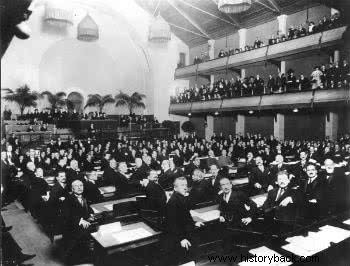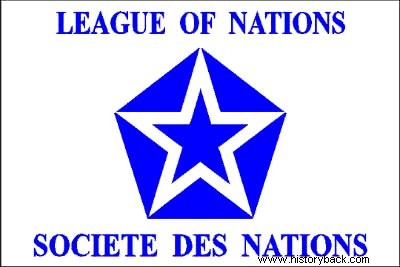The League of Nations was created by the Treaty of Versailles on July 28, 1919, at the end of the First World War.
Its main objective was to serve as a space for discussions between nations and thus avoid wars. Its headquarters were in Geneva, Switzerland.
Origin
When World War I ended, the victorious nations gathered in Versailles, France, to discuss various issues such as reparations and borders.
US President Woodrow Wilson proposes to his country's Congress the creation of an international forum. The main objective of this institution would be to resolve frictions between countries through diplomacy and not war.
This bill became known as the “14 Points of Wilson” and were accepted and incorporated into the Treaty of Versailles.

Members and Structure
The first meeting of the Council of the League of Nations took place in Paris on January 16, 1920.
The first members of the League of Nations were the victorious countries of the First World War such as France, the Netherlands and Belgium.
President Wilson, meanwhile, did not get approval from the US Senate to join the League of Nations. In this way, the creator was left out of the institution he had helped to plan.
The main body of the League of Nations was the seven-member League Council. Four permanent members participated:France, England, Italy and Japan. On the other hand, three countries were elected to occupy the temporary seats for three years.
At first, countries such as Germany and Turkey were banned from participating in the organization. However, in 1926, Germany joins the League of Nations and Turkey does so in 1932.
Also the Union of Soviet Socialist Republics (USSR) did not enter the League at first. In 1934, Stalin decides to participate in the institution as a gesture of goodwill to the West.
Brazil in the League of Nations
Because of Brazil's participation in World War I, the country helped create the League and was one of the first to join its ranks.
Brazil was for a long time the only American country with a seat on the League Council. As there were no defined rules for the occupation of temporary seats, Brazil was annually reelected to the Council.
However, being the only representative of the American continent, the Brazilian government felt that it should have more prestige. Thus begins the campaign for a permanent seat on the League Council. This became the fundamental diplomatic goal of the Arthur Bernardes government (1922-1926).
Brazil supported the thesis of "American representation" on the permanent staff of the Council. In the absence of the United States, Brazil would be America's candidate with the best credentials to fill this vacancy.
After all, it was a country of continental dimensions, large population and dynamic commerce.
However, Brazil was unable to muster the necessary support to elect itself as a permanent member of the Council. Then the country withdrew from the League of Nations in 1926.
Failure
The League of Nations was created to ensure world peace. However, the fact that it is she couldn't avoid WWII.
Among the reasons for the League of Nations not being successful we can point out:
- the absence of the new world power, the United States;
- the lack of political will among member countries;
- colonialism in various parts of the world;
- the sudden change in German politics since the rise of Hitler in 1933.
The League of Nations ended in 1942, but in 1946 it transferred all its powers to the newly created UN (United Nations).
Legacy
As we have seen, several studies point to the “failure” of the League of Nations for not having been able to achieve its main objective.
However, the League of Nations resolved outstanding territorial issues in Albania and Silesia (territory between Germany, Poland and the Czech Republic).
Likewise, there were commissions that recognized the opium trade, slavery and refugees as international problems. All these issues are on the agenda today, but at that time it was the first time they were discussed worldwide.

Curiosities
- The League of Nations took years to have a flag and logo. It was not until 1939 that two five-pointed stars inside a blue pentagon were established as a symbol.
- It was suggested that Esperanto be adopted as the official language of the organization.
- The League of Nations brought together 63 countries between 1920 and 1946. However, several were disconnected or incorporated throughout its existence.
- The League of Nations is considered the laboratory for the constitution of the United Nations (UN).
Read more :
- World War I
- Consequences of the First World War
- Causes of World War II
- Questions about the First World War
- Films about the First World War
- All About World War I
